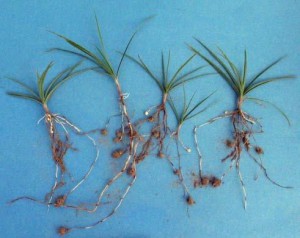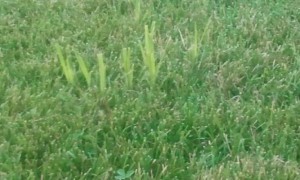From the desk of Harold Enger, Director of Education
I am very observant of what is growing in lawns and landscapes in the various regions where I travel and have noticed that each year, Nutsedge is becoming more prevalent and an increasing challenge to control.
Nutsedge is a perennial plant that increases in numbers every year. A single Nutsedge plant has the ability to produce several hundred tubers, or nutlets, every year. These tubers remain viable for 3 years or more in the soil. Each Nutsedge plant also produces underground root structures called rhizomes, which allows the plant to spread each year throughout a lawn or landscape. With an abundance of tubers and rhizomes and 2013-2014 being very wet years, this created the perfect environment for the proliferation of Nutsedge.

In residential lawns, there are two types of Nutsedge; Purple and Yellow. They get their names from the color of their seed heads. Nutsedge can be found in both cool-season and warm-season turfgrasses. They can spread rapidly from just one plant and quickly overtake desired turf, resulting in an unkempt appearance. It grows much faster than desired turfgrasses. I took this picture two days after this turf was mowed. You can easily see how it already is growing much higher than the surrounding grasses.
Even if you pull out each individual plant by hand, new plants will quickly re-grow from the tubers and the problem continues. In the area where I took this picture, there were only one or two plants last year. This year, it has spread to a much larger area.
Controlling nutsedge often requires specialized weed control products that will eliminate both the top growth as well as the underground vegetative plant parts. There are several products that are labelled to control Nutsedge, but it can take a year or more to eradicate this troublesome weed. If you have a small patch, you may be able to limit its spread by continually pulling up any new growth, but if you let it go too long, it will quickly re-establish itself.
Spring is the best time to begin controlling this plant since by mid-June, it is already producing new tubers that will lead to more plants.
Here are a couple of interesting facts about Nutsedge that I found online from Ohio State University:
- The botanical name for Nutsedge, Cyprerus esculentus, translates to “abundant edible sedge” and was cultivated in Egypt around 400 BC and is still cultivated in parts of Spain.
- Pigs find the starchy tuber a delicious treat.
- The tubers of most Nutsedge are edible. Yellow Nutsedge has an almond-like flavor and can be eaten raw or roasted. (Since I have never eaten them myself, I want to state that eating the tubers is something that you can do at your own risk.)
- Papyrus, a related species that grows 10 feet tall, was used in ancient Egypt to make paper.


